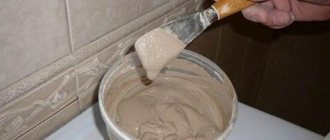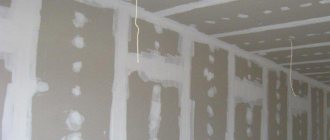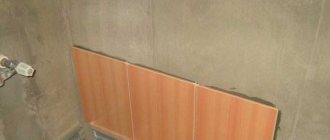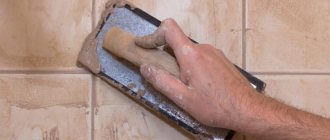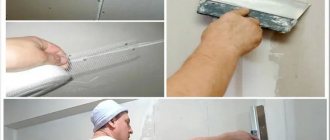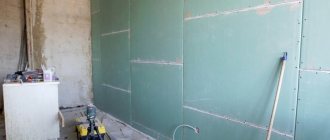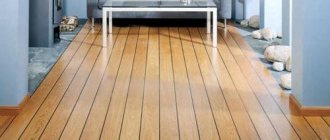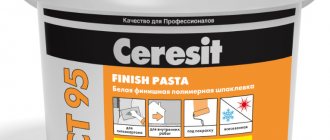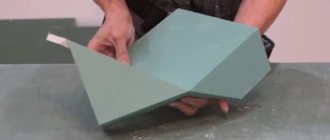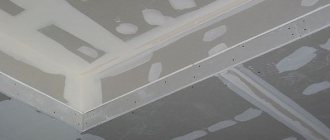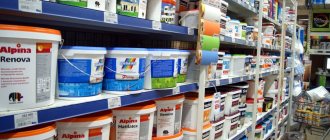The need to treat drywall seams
Putty for drywall joints is used to solve the following problems:
- increasing the strength of sections of such a foundation;
- leveling the surface, giving a uniform texture before decorative finishing;
- increasing the durability of subsequent coating design;
- prevention of cracks and chips;
- sealing self-tapping screws, fastening angles and other metal elements with putty;
- preparing slabs for painting, gluing thin wallpaper;
- creating a protective moisture-resistant layer for plasterboard sheets, etc.
Materials, tools for puttying drywall joints
Sealing seams is required using the following tools and finishing materials:
- primer;
- serpyanka or reinforcing tape;
- putty mixture;
- roller;
- set of brushes;
- electric drill with mixer;
- construction knife;
- grater with sandpaper attachment;
- container for mixing solutions;
- a set of spatulas of different sizes;
- building rule, etc.
When determining which putty the work will be performed, the following nuances are taken into account:
- indoor humidity level;
- finishing coating (for painting or plaster);
- The choice of what to putty the surfaces depends on the features of the design project;
- operational characteristics of the room (living room, bedroom, study, kitchen, etc.).
Based on the type of binding ingredient, putties are divided into the following mixtures:
- gypsum;
- polymer;
- moisture-resistant cement, etc.
Gypsum putty mixtures
Suitable for finishing joints of plasterboard slabs. The material is compatible in structure with gypsum plasterboard sheets, is environmentally friendly, safe, the durability of the composition is increased due to fillers. The putty is used for finishing rooms with optimal air humidity and is not suitable for bathrooms, bath complexes, toilets and other similar rooms due to exposure to water.
It is undesirable to use gypsum putties for the kitchen due to temperature changes and possible humidity. After drying, this material can absorb moisture, so during operation the tightness of the seams is broken, they dry out, and the finish loses its aesthetics.
Polymer putty
is universal and suitable for finishing work in premises for various purposes. The material has high performance characteristics. Polymer mixtures can be used in places with changes in temperature and humidity levels. The advantage of the composition is that there is no need for sanding after the coating has dried. The putty can be used for wallpapering or painting.
Putties with moisture-resistant characteristics
can be used to finish joints in bathrooms, kitchens, basements, rooms without heating, etc. The material is suitable for processing plasterboard floors located outdoors. The coating is resistant to temperature changes. However, it is important to take into account possible shrinkage after drying and apply a denser layer.
In accordance with the joint processing technology, several types of putty are selected:
- starting;
- finishing.
Starting finishing mixtures
Designed for applying a rough layer and filling joints. Coarse putties help to level out surface deformations and close gaps with a small amount of material. When calculating the volume of putty, the planned layer thickness is taken into account, which can reach 2 cm if necessary.
Finishing putty materials
They have a uniform texture and do not contain coarse fillers. The mixtures are applied to prepared drywall to level the surface for painting or other decorative finishing. The standard finishing coat is 1 layer.
Putties are offered by manufacturers ready-made and in the form of a dry powder.
For plasterboard sheets and joint processing, it is optimal to choose dry putty mixtures that can withstand temperature changes and are durable. The advantage of a dry product is the ability to mix the solution in small portions during the finishing process. The material is offered at an affordable price and is universal.
The advantages are also the mixture’s frost resistance, strength, plasticity, composition stability, and the ability to accurately maintain proportions. When diluting the powder with water, the recommendations indicated on the product packaging are taken into account.
Ready-made putty solutions have a higher price. Before use, the composition is thoroughly mixed in a container, then applied to joints and other plasterboard surfaces. If the rules are followed, such solutions can be stored for a long time.
Types of putties
For plastering, various types of putty are used, designed for certain conditions. There are several groups of building mixtures.
Cement
They are in greatest demand and are available in most hardware stores or supermarkets. Their advantages:
- high strength;
- moisture resistance;
- affordable price;
- Application does not require special tools or skills.
At the same time, they shrink significantly over time and do not contribute to maintaining a favorable microclimate in the living space, so they are rarely used in houses and apartments. An exception is plastering kitchens and bathrooms.
Plaster
They are also very popular because they have high adhesion to the base. They set quickly, harden, and are easy to process. Using various additives, you can change the properties of the mixture or color, which significantly expands the possibilities of its use.
Application of gypsum plasterSource myshtukaturka.ru
Disadvantage: low resistance to dampness and humidity. Even the inclusion of hydrophobic impurities does not fundamentally change the situation, so gypsum compositions are not used when finishing kitchens, bathrooms and other similar premises.
Acrylic
Such compositions are made on the basis of polymer materials. They are noticeably more expensive than their analogues, but also have excellent performance characteristics. Like cement mixtures, they have increased strength and resistance to moisture. The relief texture of the finished surface allows you to create an attractive design.
Another advantage of acrylic putty is its high resistance to mechanical damage. The material easily retains its structure under the influence of various factors and can withstand prolonged use for several decades.
Preparatory work before sealing seams
Before you putty the seams, you need to prepare the surfaces. It is necessary to check the quality of installation of plasterboard sheets, the dimensions of the joints, and the reliability of fastening the screws. The protruding caps of the elements are screwed in, incorrectly fixed screws are removed, and the fasteners are reinstalled in accordance with the requirements. The seams are examined, the areas that need to be unstitched and glued with mounting tape (sickle tape) are determined.
The joints between the plasterboard slabs are cleaned of dirt and dust, and construction debris is removed from the gaps. On the cut or factory edges, using a construction knife, indentations of 0.5 cm in size are made with an inclination of 45°. The procedure is necessary to improve the quality of adhesion of the putty mixture to plasterboard floors.
The next step is priming the surfaces. The treatment is intended for leveling the base, lightly applying putty, preparing slabs for wallpapering or painting. It is recommended to carefully prime seams and corner areas.
For drywall, it is advisable to use a deep penetration primer. After applying the product, you need to dry the surface and the joints of the plates. Then re-priming is performed. The mixture can be applied with a brush or spray. The layer thickness must be at least 0.5 mm. The coverage should be uniform.
After high-quality treatment of the area with a primer, the consumption of the putty mixture is reduced and the durability of the subsequent decorative finish increases.
Preparation
First you need to prepare the walls for the putty process. The wall should be flat, without protruding screw heads (they need to be screwed in 1 mm deeper than the sheet level). It is also necessary to check the joints of the plasterboard: the layer of paper should not peel off from the internal filling of the plasterboard sheet. If this happens, carefully cut off the peeling area and sand the surface. Otherwise, drywall from such joints may fall off or bubble over time.
USEFUL INFORMATION: Design possibilities for plasterboard ceilings
The next step is priming the drywall. This is best done with an acrylic-based primer mixture. It must be applied in two layers, using a wide soft roller to evenly cover the surface. The final layer of primer is applied only after the first has dried.
For ease of application, you can purchase a primer painted in a specific color. Then you will see exactly what part of the wall is already covered with a primer layer.
Surface treatment
After priming, the joints between the plasterboard slabs are filled. The work is being carried out in stages.
The putty composition is mixed in compliance with the proportions of powder and water specified in the manufacturer's instructions:
- The heads of metal screws and recesses are covered with putty.
- It is necessary to putty the joint areas, the solution is applied deep into the seam.
- Then the mass is distributed along the length of the seam. If there are large joints, they are distributed into sections of 2-3 m and filled with mortar.
- The mixture is pressed into the seams with a spatula to fill the empty space.
- At the end of the work, excess putty solution is removed and the surfaces are dried.
Choosing a method for puttingtying drywall seams with your own hands
Before puttingtying the drywall seams, a technology for processing the joints is selected.
Builders offer the following repair options:
- use of construction tapes for puttying;
- puttying with serpyanka;
- using perforated paper tape.
Using construction tapes when filling joints
A popular way to treat joints between plasterboard slabs is to use construction tapes during the puttying process. Fiberglass mesh can be standard or self-adhesive, suitable for adjusting longitudinal joints. However, construction tapes are not recommended for cross joints that are susceptible to cracking.
The material is available in standard sizes, so it is suitable for seams of different lengths and widths. The tapes are durable, with reinforcement and a fold in the center; they are easily applied to corner areas and joints. The strips are first coated with glue and putty solution, then applied to the areas. After drying, it is treated with putty.
Puttying with serpyanka
The application of putty for sealing plasterboard seams with serpyanka is carried out in compliance with the following steps:
- The solution is distributed onto the seams to level the base.
- The putty is pressed in to fill the recesses in the joints.
- The serpyanka is measured and cut to the marked length.
- Parts of the serpyanka are applied to the putty at the joints of the plasterboard boards.
- The material is pressed along the length of the seam.
- A wide spatula is passed over the surface of the tape to remove any remaining solution.
- After 12 hours, the next layer of putty solution is applied to the areas. The second coating is necessary to increase the strength of the base and eliminate the effects of slight shrinkage of the first layer.
- After the putty has dried, the joints are sanded using sandpaper or special equipment with an attachment.
- After completing the processing of the seams, it is necessary to prime and putty the surface of the drywall.
Seam filling using perforated paper tape
Puttying seams using perforated tape made of thick paper is carried out in stages:
- The seams are cleaned and the joints are primed.
- The joints of plasterboard slabs are treated with a thin layer of putty solution to fix the perforated material.
- Then tape is applied to the treated surface.
- When gluing, the strip is slightly stretched and held along the central part of the joint.
- The fabric is smoothed with a solution to prevent the formation of bends and unevenness.
- The tape is pressed with a spatula using movements from the middle to the edge.
- Then the remaining putty solution is removed along the perforated sheet.
- After 12-14 hours, a second layer of putty is applied to the joint areas.
- After drying, the coating is sanded.
- Then you can putty all surfaces of the drywall.
- When applying the putty step by step and accurately fixing the perforated tape, the joints will be located flush with the top layer of drywall sheets.
Putty corners
This is the most labor-intensive work, which is performed in two stages.
First, one side of the corner is puttied. The surface must be carefully leveled, especially in the part that is closer to the corner. After applying the second layer and drying, you can begin working on the second side of the corner. This way you need to create a perfectly even drywall joint. Here the putty is applied in a thinner layer.
In order to create a perfectly even corner, you can use a special corner spatula.
An aluminum construction angle must be attached to all window and door slopes to create an even and sufficiently rigid angle. You can attach it to the wall using a small amount of putty mixture. The corner must be cut to fit the dimensions of the slopes and installed around the perimeter of the openings or other external corners.
USEFUL INFORMATION: Drywall belt screwdriver
After installing the corners, they are covered with putty so that the mixture penetrates into all the holes. Using a wide spatula, the applied layer is leveled over the corner and surface of the plasterboard sheet.
Sealing self-tapping screws and gypsum board seams - step-by-step instructions (which one to choose)
Plasterboard joints are puttyed with special compounds Knauf-Fugen, Knauf Uniflot, Fugenfuller or their analogues. After the primer layer has dried, dilute the putty solution to a creamy consistency. The mass is prepared in small portions, because... it dries quickly. The screws are covered with putty mixture with a small spatula, and the remaining mortar is removed. The surface should remain flat.
The nuances of how to properly putty drywall joints differ depending on their location, size and configuration.
The joints along the long side of the slab are uneven and can be easily filled with mortar. Sheets can be connected vertically in height. The technology for processing edged plasterboard slabs at joints is different.
How to putty vertical joints
When puttingtying vertical joints of plasterboard sheets with finished factory edges, the work is performed in compliance with the following steps:
- The joints are cleaned and filled with ready-made mortar.
- Before the finishing mixture dries, the joints of the slabs are glued with reinforcing tape or sickle mesh to prevent the formation of cracks.
- When using paper tape, the canvas is cut into pieces, which are soaked in settled water for 10 minutes. Then the strip is glued to the seam, ironed with a medium-sized spatula and pressed from the middle part to the edge.
- Finally, the surface covered with plasterboard is treated with finishing putty, and the joint is leveled with the base.
- After preliminary work, these areas can be plastered with decorative compounds, painted, wallpapered, etc.
Trimmed seams on drywall
Plasterboard surfaces with cut seams without factory edges can be puttied only after preparation.
The work is carried out in compliance with the following steps:
- The surfaces of the drywall at the joints of the boards are moistened several times with water using a brush.
- Then, using a sharp utility knife, grooves are cut at a 46° angle before priming.
- The prepared areas of the joints of plasterboard slabs are coated with a primer solution using a brush.
- After the layer has dried, the seams are filled with a special putty.
- The cracks are sealed with a solution using a small spatula, and excess composition is removed with a wide tool.
- The mass is pressed into the seams to prevent subsequent cracking of the finish.
- The putty solution is once again applied to the seam in a layer 0.5 mm thick, and reinforcing tape is fixed on top of the solution.
- The material is pressed to the base with a spatula, and the remaining putty solution is removed.
- The reinforcing tape is straightened, a thin layer of putty is applied on top and distributed over the surface.
The second technology for sealing seams for drywall joints: first with tape, then with putty
The next method involves gluing reinforcing paper tape or sickle tape to the drywall, then applying putty. The disadvantage of this option is the possible formation of voids in the joints under the tape. In this case, it is optimal to use self-adhesive sickle tape. After the material has dried, the surface is carefully puttied.
The method can be used in small areas. When finishing long joints and processing a large area of plasterboard floors, irregularities and waves may remain.
"Knauf Uniflot"
Knauf Uniflot putty is a specialized super-strong waterproof mixture for plasterboard joints, its properties superior to all analogues.
- The increased strength brings it to the same level as the cement composition, however, the putty in question is significantly superior to it in ductility.
- Good adhesion, which brings this type of putty closer to synthetic glue, makes it possible to seal gypsum board joints with a semicircular thinned edge (PLUK) without the use of reinforcing tape.
- The composition does not shrink and does not crack.
- Perfect for sealing the most problematic transverse joints between gypsum boards.
- Suitable for rooms with any humidity. Despite the fact that the base of the mixture is gypsum, the putty does not absorb water after drying, acquiring hydrophobic properties.
USEFUL INFORMATION: How to cover radiators and pipes with plasterboard
The color of the powder can vary from snow-white to gray and even pink: this factor is associated with the location of gypsum extraction and does not affect the quality of the mixture.
Knauf Uniflot putty is designed to work no longer than 25–30 minutes. After this, the solution hardens. Hardened putty forms a durable coating, and it is difficult to sand it with sandpaper. The composition should be applied without calculating shrinkage, since the protrusions will then have to be ground down for a long time.
Work order:
- the joints are filled, the composition is pressed in with a 150 mm wide spatula;
- after 50 minutes, excess material is removed, the surface is smoothed with fresh putty;
- the recesses from the screws are also processed in 2 passes.
When chamfering yourself at joints, you should use reinforcing paper tape, as for other compounds.
The high cost of the Knauf Uniflot putty mixture is compensated by the quality of the material. In addition, the sealed seam does not require much consumption.
External and internal corners
For finishing internal and external corners on partitions and walls made of plasterboard boards, the following materials are used:
- serpyanka;
- reinforcing paper;
- aluminum perforated corners;
- metal corners Shitrok with paper inserts.
Reinforcing paper and sickle tape are often used when decorating internal corners (at the junction of wall panels, the junction of walls and ceilings).
The work is carried out in stages:
- a little putty solution is applied to the corner parts;
- Serpyanka or paper reinforcement is placed on top;
- Using a narrow spatula, the canvas is pressed into the mass;
- the remaining putty is removed;
- then treat the corner again with a thin layer of putty.
Perforated corners are used for finishing external corners (slopes, protrusions, etc.).
The work is carried out in stages:
- it is necessary to cut off part of the corner of the required length with scissors for working with metal;
- the edges are cut at an angle of 45° or a smaller slope; it is not allowed to make a corner at 90° for plasterboard structures;
- putty solution is applied to the outer corner on both sides in small parts with an interval of 10 cm in a checkerboard pattern;
- a perforated corner is pressed into the putty solution;
- the accuracy of placement horizontally or vertically is checked, if necessary, the location of the corner is adjusted;
- the remaining mortar is removed with a spatula, the edges are aligned into a single plane with the surface of the drywall;
- the fixed corner is left until the putty dries;
- then the surface is polished;
- If necessary, the putty is reapplied.
Installation of the Shitrok corner is similar to the installation of perforated elements. However, the transition to the plasterboard plane of the corner element is more convenient due to the presence of paper inserts and a metal base.
Sealing materials
How to seal seams, what can you use if you decide to do the work yourself? You can use different types of materials, but it is better to use a “comprehensive” approach.
Paper tape
Paper tape is sold in rolls of 50 - 150 meters, the width is usually about 50 millimeters. Paper tape is stronger than regular paper because it is reinforced with fiberglass in different directions. The surface of the strip is not smooth, but rough, which is necessary for reliable adhesion to plaster, gypsum putty or other finishing materials.
There is an insert in the center of the tape that makes working with the material easier. The tape can be glued not only between sheets - it is possible to reinforce the corners of a gypsum board structure. Unlike ordinary paper tape, the tape layer does not wrinkle or stretch.
The disadvantages of the finishing method include the complexity of installation compared to a simple serpyanka. If the putty was carried out in violation of the technology, air will get under the paper tape - sooner or later the material will peel off. But perforated tape does not have such a disadvantage, for which putty does not have such an important role.
Self-adhesive serpyanka
Typically, experienced finishers use serpyanka when repairing ceilings and walls to seal joints on gypsum boards. The material is sold in rolls of 20 - 90 meters, and can have different widths - up to 5 cm or more.
The most convenient mesh is self-adhesive; it is convenient to attach it to sheets of drywall with any edge. Serpyanka can be used to repair cracks, chips, holes, for example, under wallpaper. There is also a regular, non-self-adhesive mesh on sale, which is much more difficult to attach, but costs an order of magnitude cheaper.
It is better to buy a small roll of self-adhesive material, because after opening it will not be possible to store it for a long time due to loss of properties.
putty
Puttying is an excellent method for sealing the seams between gypsum board sheets. It is recommended to putty the joints if the room is being prepared for painting or for covering with thin paper wallpaper.
The putty mixture must be of excellent quality, otherwise it will crack over time. It is necessary to pay attention to the ability of the product to resist shrinkage.
Gypsum-based putties and grouts are a suitable option for drywall and provide a smooth, durable surface that is perfectly white. It is better to putty with a proven product from a reliable brand, for example, Knauf.
Primer
Priming already sealed seams is a mandatory step in the process of sealing them. The primer will act as a binding component, completing rough repairs of the ceiling or walls before finishing.
Which primer is best? It is worth buying a product with antiseptic and fungicidal additives that protects the surface from the appearance of fungus and mold. After covering with primer, gypsum plasterboard will not be afraid of moisture, especially if the solution is applied in 2 - 3 layers.
Plaster
The plaster mixture is used as a finishing coat to create a beautiful, smooth surface instead of a prominent joint. It is recommended to cover the base with plaster to enhance the degree of adhesion of gypsum board sheets with subsequent coatings.
Sanding seams and corners of drywall for wallpaper
Finally, the surface of the drywall is sanded with sandpaper of a suitable grain size or with a grinding machine with attachments. It is recommended to check for unevenness using artificial lighting. Grinding work is carried out wearing safety glasses and a respirator.
To prepare surfaces for painting, sandpaper marked P400-600 is used. To give the puttyed drywall a matte smoothness, P1000 paper is used. Final polishing is performed with sandpaper marked P1200.
If there are uneven surfaces, you can treat the walls with coarse sandpaper. Then apply sandpaper with medium grit - P80-280. Rough sanding is performed with paper marked P40-60. After sanding, the surfaces are primed again.
Rules for puttying surfaces in the bathroom
You can’t just apply the mixture to the walls and smooth it out. There is a whole range of activities that precede such work. Any surface, even if it seems ideal, needs preliminary preparation.
Preparatory stage
Advice! It happens that large cracks or holes are found between the seams on the walls or ceiling. They are sealed using cement plaster. Although this work can be simplified a little, for this purpose they use polyurethane foam. It seals large damage well and does not require much effort to apply.
Puttying
Putty for the bathroom must contain the inscription on the packaging - suitable for wet rooms, and also belong to one of the types listed above. Thus, we can say that the main condition will be achieved a priori. Namely, the mixture will have the necessary qualities. But now another problem arises; it needs to be applied correctly.
It is especially difficult when surfaces are supposed to be painted. The fact is that the paint immediately detects and highlights all existing defects.
Determine the required number of layers. If the work is carried out on already applied plaster, then you can limit yourself to the finishing mixture. When there are significant unevennesses that require applying a solution one centimeter thick, then they resort to starting putties.
Starting putty - used in the presence of significant unevenness, cracks and differences
Dry cement putty is often used; it needs to be prepared:
- Pour the required amount of the composition into the container, add water little by little, constantly stirring with a drill with a mixer attachment.
- You need to obtain a paste-like consistency, which is left for 10 minutes. This is done to ensure that all additives are completely dissolved. After this, stirring is repeated.
Dilution of dry putty
The most difficult part begins - applying the mixture to the surface. Although if you practice a little, you will find that everything is not as scary as it might seem at first glance.
For work, two main tools are used: a medium and large spatula; a small one is kept in reserve; it will be needed for puttying in hard-to-reach places.
With the help of these simple rules, it is possible to apply starting and finishing compositions in any wet areas.
After complete drying, the surface is sanded. If you want to get a perfectly smooth, almost mirror-like layer, then use the glossing method.
Surface grinding is the final stage of putty work.
